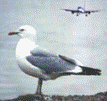Bird Strike Committee Proceedings
Date of this Version
August 2006
Abstract
Not only birds residing at airports, but also birds commuting daily across the runways from and to places outside the airport boundaries, may pose a threat to departing and landing aircraft. Species such as gulls, geese, cormorants, ducks, flamingos, starlings and crows often have foraging sites that can be miles away from their breeding or roosting places. Dealing with those commuting birds that pass over airports on a daily basis is complicated because their roosting, breeding, and foraging sites do not belong to the airport’s property. The solution to the problem becomes even more complex when these sites are part of protected nature areas; local, national, and international laws increasingly require states to protect birds and their habitats. Airport authorities are caught in a dilemma because recently (2003) enacted standards by the International Civil Aviation Organization (ICAO) require that “the appropriate authority shall take action to decrease the number of birds ... by adopting measures for discouraging their presence on, or in the vicinity of, an aerodrome” and “any such other source attracting bird activity on, or in the vicinity of, an aerodrome shall be eliminated or their establishment prevented…”. How can airport authorities deal with these conflicting regulations and mitigate hazards caused by commuting birds to departing and arriving aircraft? Different approaches for current and future situations at various airports throughout the world, ranging from shooting the commuting birds as they cross the airport boundary to adjusting flight schedules of aircraft, will be discussed.

